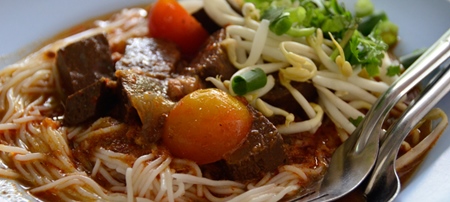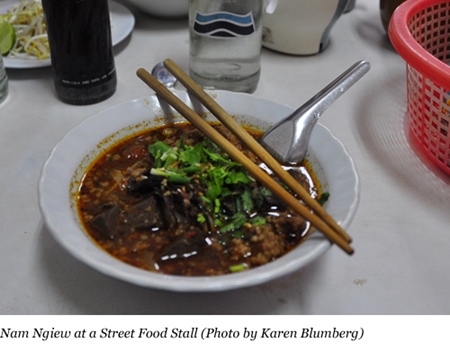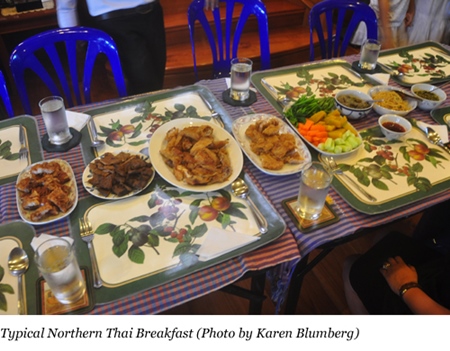EXPERIENCE: NORTHERN THAILAND ON THE TABLE
Everyone has a dish that reminds them of their childhood. It’s the one dish that people usually think of as their “comfort food”, the one that people think of when they think of their families and where they grew up. It’s also the dish that tells you the most about someone.
Since I grew up in the United States with a father from Chiang Rai and a mother from Chiang Mai, it’s no surprise that the dish that figures most prominently in my childhood is a Northern Thai one. No, not khao soy – the curried egg noodles so popular among visitors to the region and said by some to have originated in Chiang Mai.

Instead, kanom jeen nam ngiew is the dish that smacks most of home: fermented rice noodles, minced pork and/or beef, fermented beans, stewed tomatoes and, typical for the meat-loving North, cubes of congealed pig’s blood. Most importantly, a real version of this dish must include dok ngiew, dried flower blossoms that resemble sawed-off brooms. Any dish without this ingredient is likely to fall short.

Although this noodle dish might seem wildly exotic – my father dubbed it “Thai spaghetti” to coax us into eating it as children – it’s relatively easy to find in Bangkok and, obviously, up North in popular tourist destinations such as Chiang Mai. Many a kanom jeen stand, identifiable from the strands of rice noodles visible on the counter (or the plates of kanom jeen garnishes like basil, chopped cabbage and pickled greens on the tables), offers this bolognese-like ragu, which is meaty and rich, and flavorful in a way typical of Northern Thai food: salty and spicy, with a hint of acidity from traditional garnishes like lime and pickled greens, bitterness from the deep-fried garlic, and crunch from the pork rinds that usually come with it.

Up North, it is easy to find these noodles in stands that specialize in Shan-style food – after all, this dish is supposed to be adopted from the Shan, an ethnic group known for living mostly in Myanmar. This is why you will frequently also find the Shan-style dish khao ganjin – rice steamed in pig’s blood and wrapped, Japanese onigiri-style, in a banana leaf. While this delicacy also sounds very bloodthirsty, it is surprisingly delicious when paired with its standard accompaniments, fresh sprigs of coriander and lashings of deep-fried garlic.

But these two dishes aren’t the only ones Northern Thailand has to offer the adventurous diner. The region is a treasure trove of typical Thai favorites, often done with a little twist to fit into the Northern Thai flavor profile of salty and spicy, with a little sour and bitter thrown in. Som tum, a popular spicy-tart salad synonymous with the Isaan region in Northeastern Thailand, is frequently made with green papaya and is a street food standard all over the country. In the North, however, it is made with papayas that are beginning to yellow, mixed with dried spices and bereft of the peanuts, green beans and sugar that figure so prominently in the most popular type of grated salad, som tum Thai.

As with any other type of som tum stand, vendors are easily recognizable by their ingredients – papayas, tomatoes and chilies – and the gigantic mortars and pestles that inevitably crown their work stations. Luckily, they are also easy to find: usually, on the outskirts of any good-sized wet market in any city in Thailand.
Or perhaps it is curry you are searching for. There is no curry better-known in the North than the Burmese-inflected favorite, gaeng hang lay, a mild, sweet mix of tamarind, ginger, fermented beans and pork belly. Readily available at any khao gaeng (rice and curry) stall in the North, this curry can be spotted by its reddish-brown color and the hunks of moo sam chan (three-layer pork) seen floating in the murk. Just look for stands that resemble roadside buffets, with different stir-fries and curries set out in metal containers on tables.
Finally, no Thai meal is complete without nam prik (chili paste), considered a pillar of Thai cuisine and long employed as a prime and easily-transportable source of protein. Sometimes eaten as a “dip”, sometimes the main course, nam prik comes in many variations throughout the country. It’s no surprise, then, that Northern Thailand can boast its own varieties, the most popular being the roasted green chili dip known as nam prik num.
Despite its fierce appearance, this paste is more tart than spicy, frequently accompanied with pork rinds, sai oua (Northern Thai sausages of pork, fresh turmeric, slivered kaffir lime leaf and shallots) and a smattering of blanched greens, cooked pumpkin and boiled bamboo shoots. Fortunately, there is no way you can miss this chili paste; any wet market in Northern Thailand will feature samples of nam prik num (and its traditional accompaniments) in its ready-to-eat food section. Bangkok markets are also no stranger to this wildly popular Northern Thai dip.
But, if you are willing to go a little crazy, you can venture into unfamiliar territory: the kitchen. Why not just make yourself a taste of the North, and my childhood, courtesy of my family’s own recipe?
NAM NGIEW (FOR 10)
Preparation:
1. Nam Prik: Grind the following together well:
Dried pepper – 30 pieces
Dried Bird Chillis – 30 pieces
Shallots – 0.2 Kilos
Garlic – 0.1 Kilos
Shrimp paste (kapi) – 0.1 Kilos
Lemongrass – 3 pieces (stems)
Salt – 1 tablespoonful
Grilled dried fermented bean paste – 0.2 Kilos
2. Next, boil until slightly soft:
Pork spareribs, cartilage parts – 1 Kilo, cut into 1-inch pieces.
Save the cooking liquid.
To cook:
Fry the “Nam Prik” in hot vegetable oil in a big pot until it “smells good” (the inside of your nose tickles). Add 1 Kilo of ground pork and the cooked spare ribs. Stir until cooked. Add the soup from the cooked spareribs. Then add 1 Kilo of cherry tomatoes, cooked pork blood in pieces and 0.1 Kilo of dried “Ngiew Flowers”. Add 0.2 Kilo of Black Tao Jeao. Boil at medium temperature until well blended. Before serving on kanom jeen, add fish sauce and lime juice to your taste.
Serve with:
Deep fried chopped garlic
Chopped shallots
Cut limes
Cut pickled greens
Ground deep-fried dried chilies




